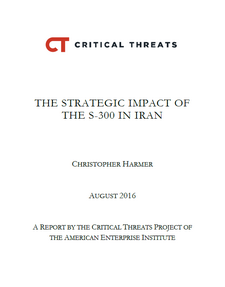{{currentView.title}}
August 18, 2016
The Strategic Impact of the S-300 in Iran
 Executive Summary
Executive Summary
Debate about whether or not Russia would deliver the long-promised S-300 surface-to-air missile (SAM) system to Iran has somewhat obscured the strategic implications of the delivery that is now taking place. The years-long back-and-forth between Moscow and Tehran over the issue highlighted tensions in the relationship, which appear to have been resolved.[1] The deployment of S-300 components to Iran, however, is a strategic game changer in the region, and a challenge to which international attention should now turn.
 |
The US military can defeat the S-300, it is true, but only by devoting significantly more aircraft, including our most advanced stealth aircraft, to a major military effort aimed at eliminating that system before proceeding to any other targets. Arab and Israeli militaries do not now have the capability to reliably defeat the S-300 with conventional means. That is particularly true if Iranian reports that Russia is delivering a more advanced version of the system are accurate.
Regional militaries will need to purchase the most advanced US airframes and weapons and develop new operational approaches if they wish to retain their current abilities to conduct airstrikes into Iran. If they choose not to field those capabilities, Iran will have eliminated an important element of regional deterrence against its activities. If they do, then the S-300 deployment will have helped fuel a regional arms race.
S-300 Overview
Russia has reportedly begun delivering the missiles for the S-300 surface-to-air missile (SAM) system to Iran.[2] Separate nonmissile components of the system, including missile tubes and radars, were previously delivered and shown during Iran’s Armed Forces Day Parade on April 17, 2016.[3] If Russia delivers all components necessary for Iran to have a fully functional S-300, this will have a significant impact on the balance of military power in the region.
The S-300 is a family of SAM systems capable of identifying, targeting, and shooting down multiple aircraft and missiles. Depending on the missile variant and associated components, the S-300 can be used against fixed- and rotary-wing aircraft, unmanned aerial systems, short- and possibly medium-range ballistic missiles, cruise missiles, and air-launched standoff weapons.[i4] The S-300 can work as part of a larger integrated air defense system (IADS) or function as a standalone, road-mobile unit with limited off-road capability.[5] It is an advanced system that is difficult to jam or spoof. Defeating the S-300 requires a combination of manned aircraft with various capabilities as well as standoff munitions. The US military can accomplish this task, but few other militaries can.
The S-300 was first deployed in 1980 and has undergone numerous modifications and upgrades since then.[6] There are land- and sea-based variants, as well as domestic and export versions. NATO has assigned designations to some of these variants, including the SA-10 Grumble (the original S-300 system), the SA-20 Gargoyle (the more advanced S-300 PMU-2 system, which the Russians call Favorit), and the SA-21 Growler (originally known as the S-300 PMU-3, now known as the S-400, which the Russians call Triumf).[7] The more advanced systems have significantly more capability than the earlier variants.
The S-300 consists of several major components, all mounted separately on road-mobile (but not all-terrain) vehicles. They include search radar (to find and track incoming aircraft), fire control radar (to target missiles and help guide them to their targets), command module, transporter erector launcher (TEL) unit, and missiles.[8] The Russians continually upgrade the individual components of the system. The upgrades are mutually compatible such that customers can field various “mix and match” combinations of the different components.[9] This ability to integrate older legacy components is critical to Iran, which already has significant quantities of surplus Russian equipment. It will also allow Iran to upgrade the S-300 incrementally if and when Russia provides more advanced elements of the system. Russian forces are currently upgrading their own air defenses to the S-400/S-500 systems.[10] That process will likely free up additional advanced S-300 components, which the Russians could provide to Iran.
To read the full report, click here.
Chris Harmer is a senior naval analyst at the Institute for the Study of War.
